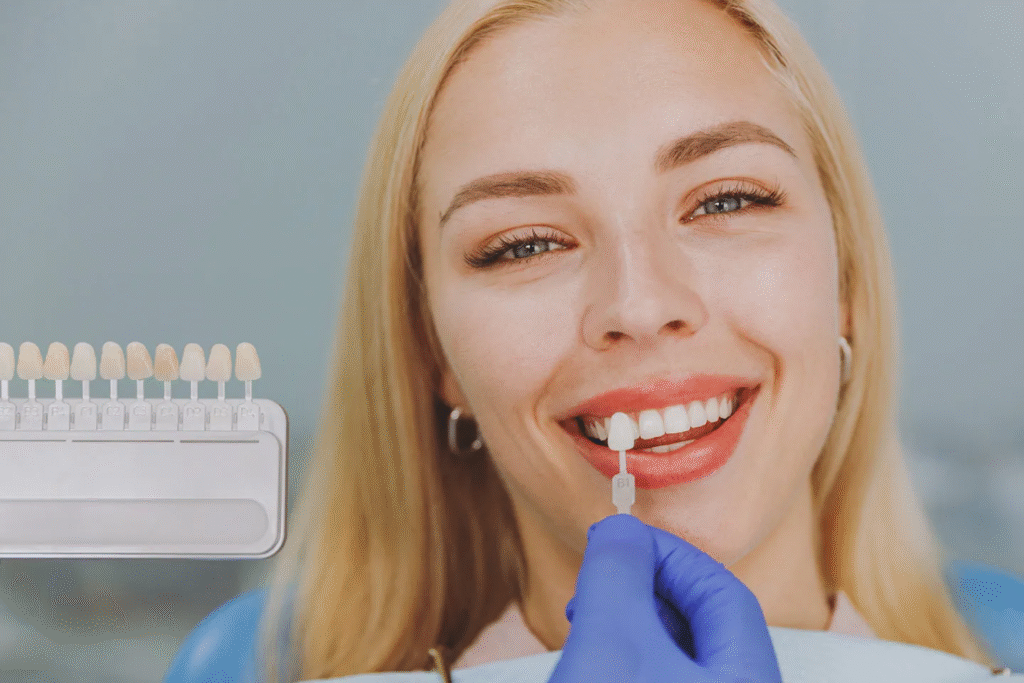Understanding What Cosmetic Dental Care Is
Cosmetic dental care provides elective or desired treatments and services to improve a patient’s smile. People may want cosmetic dental care for various reasons, from color correction to replacing missing teeth. According to the American Dental Association, teeth discoloration is one of the most common cosmetic complaints, with 90% of patients wishing their teeth were whiter.
Some cosmetic dentistry forms have been around since ancient times, but modern technology has led to great improvements in the last few decades. The materials used in treatments today are much more durable and natural‑looking. While cosmetic dental care’s primary aim is to improve appearance, treatments can also provide restorative benefits. An example of this is dental fillings, which are considered restorative and cosmetic to a certain extent. Patients can opt to use porcelain or composite filling material to match their teeth’ color and maintain their natural appearance.
Cosmetic Dental Care Options
Any type of dental treatment used to improve the teeth’s appearance qualifies as cosmetic dentistry. Dentists often use a combination of cosmetic procedures to help patients achieve their desired results. Some of the different types of cosmetic dentistry treatments are:
- Dental Implants: Replace missing teeth by anchoring artificial teeth to the natural root, enhancing both appearance and function.
- Gum Recontouring: Reshape gums that are receded or overextended to properly frame teeth and improve smile aesthetics.
- Inlays and Onlays: Fit inside or over cracked teeth to restore strength and appearance, often used on back teeth.
- Teeth Whitening: Professional bleaching agents remove stains from foods, beverages, medications, tobacco, and aging.
“Any type of dental treatment used to improve the teeth’s appearance qualifies as cosmetic dentistry.”
Choosing the Right Treatment and Cosmetic Dentist
Patients should carefully research and consider their treatment options. It is also essential to use careful consideration when looking for a qualified cosmetic dentist. Criteria include the dentist’s experience, continuing education, technologies used, and patient results.
The initial consultation is an opportunity to learn about the practice, express your needs, and have the cosmetic dentist recommend the most beneficial treatments. During this visit, the dentist will take X‑rays, impressions, and review tooth shape, size, and color to create a custom treatment plan.
Home Care Routines
Home care and maintenance differ by treatment, but all cosmetic treatments require excellent oral hygiene. Brush twice daily and floss at least once a day, and visit the dentist for routine checkups.
For dental implants, use a soft toothbrush and low‑abrasive toothpaste, floss with unwaxed tape or implant‑specific floss, and consider an oral irrigator to clean around the implant.
After gum contouring or whitening, rest your mouth and avoid rigorous activity. Stick to soft foods and avoid spicy, sticky, or acidic items while tissues heal.
Dental Care Routines
For all cosmetic treatments, patients should follow individualized care instructions from their cosmetic dentist. Generally, brush twice daily—ideally after every meal—and floss once a day to remove debris and support healing.
Regular follow‑up appointments ensure that treatments are progressing well and allow the dentist to adjust care plans as needed.
FAQs About Cosmetic Dental Care
Q. Is cosmetic dental care comfortable?
Most patients don’t experience discomfort during cosmetic dental procedures. Patients with dentures or implants may feel slight soreness while adjusting. Any discomfort can be managed with over‑the‑counter pain relief.
Q. Who is a good candidate for cosmetic dentistry?
Anyone unhappy with their smile’s appearance can benefit. Cosmetic treatments address missing teeth, discoloration, crookedness, and other aesthetic concerns.
Q. What should patients expect from a cosmetic dentist?
A cosmetic dentist combines multiple procedures to enhance your smile. Treatment may span several appointments, and results depend on individualized plans and techniques.
Q. How should patients choose a cosmetic dentist?
Research training, technologies, and patient reviews. A strong consultation process helps you evaluate the dentist’s expertise and determine if they’re the right fit.
Q. What types of cosmetic dentistry are available?
Options include implants, whitening, veneers, bonding, crowns, bridges, gum recontouring, inlays/onlays, and more. Your dentist will recommend a combination tailored to your goals.
Important Dental Terminology
- Allograft – A graft of tissue from a donor of the same species as the patient who is not a genetic relative.
- Alveolar Ridge – The bony ridge on the roof or floor of the mouth that holds the tooth sockets.
- Autograft – A graft of tissue from one portion of an individual’s body to another.
- Bleachorexia – The harmful overuse of teeth whitening products without professional guidance, damaging enamel and gums.
- Cap Splint – A device used to treat jaw fractures or cover crowns of teeth, made of plastic or metal.
- Cosmetic Dentistry – Dental work aimed at improving the appearance of teeth, gums, and bite.
- Crown Lengthening – A surgical procedure to expose more of the tooth structure for aesthetic or restorative purposes.
- Dental Crown – An artificial cap, often porcelain, placed over a prepared tooth to restore its shape and function.
- Dentin Hypersensitivity – Pain resulting from exposed dentin when enamel wears away, exposing the tooth nerve.
- Dentist – A healthcare professional specializing in diagnosing, preventing, and treating oral health conditions.
